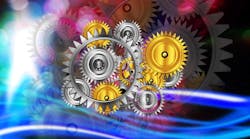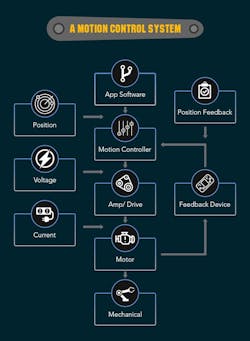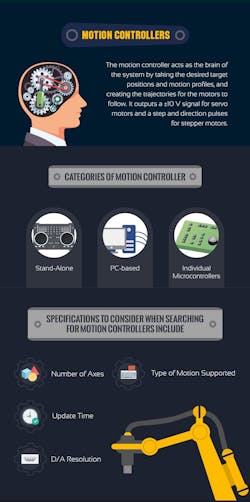Recently I came across a simple infographic from Power Jack Motion that did a nice job of visualizing the difference between alternating current (ac) and direct current (dc) motors. This article will follow and present the information contained therein.
What is Motion Control, Anyway?
Motion Control is a sub-field of automation encompassing the systems or sub-systems involved in the moving parts of machines in a controlled manner. Using a computer to control an actuator offers benefits, but today getting data and feedback is increasingly important.
Some companies are already seeing the advantage of adding sensors and feedback to a production line. In addition, this extra information can let machines communicate to each and connect to the internet to take advantage of the Industrial Internet of Things (IIoT).
Today motion control often includes a blend of electronics and mechanical components divided into three parts, which have been seen as analagous to how the human body operates.
|
Motion Control |
Humans |
|
Processor or Motion Controller |
Brain |
|
Actuator |
Muscles and joints |
|
Sensors |
Senses |
To elaborate on this further, the infographic added more detail.
Processor or Motion Controller
There are three types of motion controllers: standalone, PC-based, and individual microcontrollers. This is becoming more and more of an important consideration when setting up production lines. To prevent incumbent inertia and future-proof a production line, the manufacturing brain is evolving.
Previously programmable logic controls (PLCs) were the go-to controller—a robust, centralized control that could be put into a protective enclosure and have everything connect to it. However, as production line advance, the amount of cables, complexity, and cost has increased. Today a PLC that focuses more on software might be better to handle the automation advancements. The programmable automation controller (PAC) does just this. While it expands the capabilities of a PLC, the difference in terms is debatable.
There are individual microcontrollers that allow a production line to add features while not affecting legacy equipment, or letting companies start taking advantage of the IIoT with less commitment. To combat legacy equipment, some older PLCs may continue to run while a new automation process is added.
For example, a new inspection system could accept or reject parts on a line. The legacy equipment might not see this. The legacy equipment only sees a part going in one side and out the other. It can be blind to the new equipment—so long as it knows what to do with the output from the new equipment, it can continue to run as it previously has.
Amplifiers and Drives
There are many types of amplifiers and drives, and there is a lot to dissect here. But when looking at advanced automation, servos look like they are able to add more value and feature to a line when compared to stepper motors. However, this can add more cost and complexity. Servo drives and servo amplifiers transform a low power current/voltage applied to the servo motor windings to produce torque. Different amplifiers include analog servo drives, sinusoidal, trapezoidal, digital servo drives, single phase (brushed) servo drives, three phase (brushless) servo drives, and electric vehicle motor control.
|
Key features of ac and dc motors |
|
|
AC |
DC |
|
Low power demand on start |
Easy installation |
|
Controlled acceleration |
Speed control over a wide range |
|
Adjustable operational speed |
Quick starting, stopping, reversing, and acceleration |
|
Controlled starting current |
High starting torque |
|
Adjustable torque limit |
Linear speed-torque curve |
AC synchronous motors
Feedback Sensors and Mechanical Components
Feedback sensors provide motor location. There are several types, including:
- Quadrature encoder: Gives position relative to the starting point
- Potentiometers: Gives analog position feedback
- Tachometers: provides velocity feedback
- Absolute encoders: for absolute position measurements
- Resolvers: convert mechanical motion into an electric analog signal to find an absolute position
Overall, motion control is complex, and gaining an understanding of everything is difficult. Simple inforgraphics such as the one described in this article help to simplify things, making it easier to determine which expert or company you should be talking to.





